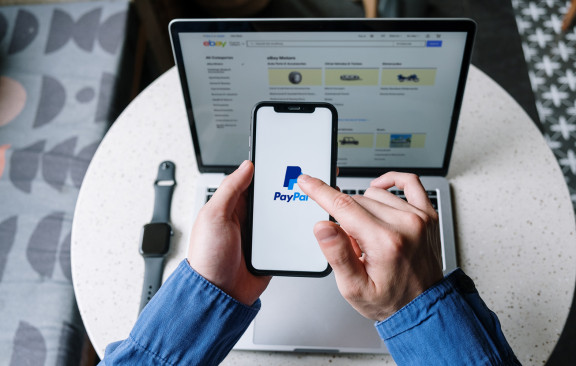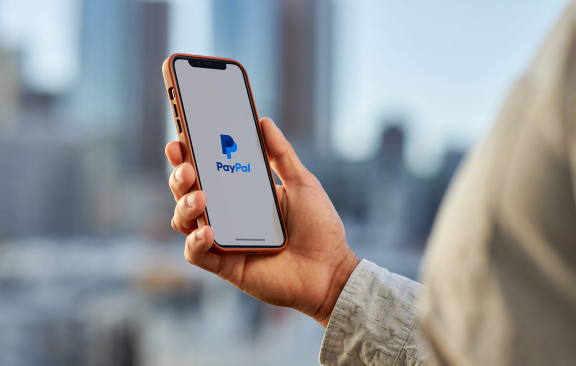Surely, you’ve heard of PayPal, right? It is one of the oldest and biggest online payment systems in the world. It was founded in 1998 under the name Confinity, but you probably know it better as the electronic payment system that billionaire, Elon Musk co-founded.
Over the decades, many online and mobile payment systems have been introduced, but PayPal remains among the most popular. Part of it is the platform’s credibility due to its longevity, but another reason is its ability to adapt to the evolving needs of the paying public.
Let’s talk numbers: As of the third quarter of 2022, PayPal had 432 million users. While growth in the last couple of years has slowed, there is still an upward trajectory. And in the last couple of years, PayPal revenue reports are as follows:
- 2022 revenue reached $27.5 billion, which is an 8.6% increase compared to 2021
- 2022 net profit saw a decline of $2.4 billion compared to $4.1 billion in 2021
- Some 22.3 billion PayPal transactions were completed in 2022
- 2022 transaction volume reached $1.36 trillion
Let’s talk about why PayPal remains incredibly popular as a payment platform.
Why do so many people use PayPal?
With so many different payment systems available today, why do hundreds of millions of people still use Paypal?
That’s because it has many advantages for online purchases:
Security
Once you input your bank and credit card information into your PayPal account, you never have to do it again. Sweet!
All of your information is kept private and secure. Even better!
And instead of entering these details over and over again on various eCommerce platforms, you can just navigate to PayPal.
Multiple fund sources
Have you ever experienced your credit card being declined in a retail store? Embarrassing, huh? You will never experience that with PayPal, as you can use multiple fund sources for your account.
Plus, you will always see the remaining fund amount on your account page.
PayPal app
With the PayPal app, online transactions are much simpler. Every transaction is confirmed with a PIN, which ensures maximum customer privacy and cybersecurity. That’s all you ever need in an electronic payment system.
Free
PayPal doesn’t ask for annual membership fees, processing fees, or service charges.
Discounts
Here’s the best part: PayPal users also get discounts when shopping at select retailers.
We’ve established that PayPal is great for users, but how can eCommerce businesses take advantage of the online payment platform’s popularity?
Why you should use PayPal for your eCommerce business
Your eCommerce business must have a payment gateway or system that is versatile and can be used by thousands of customers. If you want to entice as many people to your online store as possible, you must make their buying experience easy and convenient.
Accepting PayPal payments is a must because of its many advantages. However, it also has its faults.
Check out the good and not-so-good points of having PayPal as a mode of payment in your eCommerce store:
Pros:
- Easy to use - PayPal has one of the most user-friendly processors among online payment platforms.
- Safe and secure - It has top-notch and updated encryption technology to prevent hackers from stealing data.
- Fast - Your money will be in your account within minutes after a completed transaction.
- Simple international transactions - PayPal accepts dozens of currencies, and it will automatically convert payments to your preferred currency.
Cons:
- High chargeback fees - PayPal has higher chargeback fees than many of its counterparts.
- Higher merchant fees - Credit card companies have lower merchant fees compared to PayPal.
- Long account suspension - When you violate the terms and conditions, even if it was unintentional or by accident, PayPal will freeze your account for months.
Now that we have sufficiently discussed PayPal, let’s consider the best PayPal alternatives for your eCommerce business.
Let’s dive in.
10 PayPal alternatives for eCommerce stores
1. Stripe

What it is: Over two million people use Stripe, and more than 3.1 million websites use it for payment processing. While many startups struggled during the pandemic, Stripe thrived and was valued at $95.6 billion as of 2021. A big reason for its exponential growth is that it accepts over 135 currencies, making it a breeze to use for global eCommerce sites and customers worldwide. And that’s why it’s number one on our list!
How it works: Another reason Stripe is so popular is that it’s very easy to set up: in just a few steps, et voila! You have an account where you can process dozens of payment methods, including credit cards, debit cards, Apple Pay, Google Pay, and more. There is also a Stripe Terminal for in-person payments for eCommerce businesses with brick-and-mortar stores.
How to integrate it to your eCommerce store: The steps are easy to commit to memory: register, verify your email, and provide information about your business. Most businesses will receive their approval email within 24 hours. Once approved, go to your eCommerce website and look for the “payments” setup to add Stripe as a payment gateway.
Fees:
- No setup fee or monthly fee
- 2.9% + $0.30 per transaction
- Additional 0.5% for manually entered cards
- Additional 1.5% for international cards
- +1% when there is a currency conversion
2. Braintree

What it is: Braintree is the brainchild of PayPal—pun intended. It is a payment platform optimized specifically for eCommerce businesses. It provides robust customization options because companies have different needs. While it doesn’t have millions of users like PayPal and Stripe, tens of thousands of American businesses are raving about its simplicity and transparent pricing. Unlike PayPal, Braintree accepts cryptocurrency as payment.
How it works: Braintree offers two options for merchants, but because it is owned by PayPal, a PayPal business account is needed. It integrates with PayPal through the Braintree software development kit (SDK), which means you will see the PayPal button when you pay at checkout.
How to integrate it to your eCommerce store: Integrating Braintree into your eCommerce site will need some programming knowledge. Uh-oh. You need to work with the platform’s application programming interface (API). But it works with all major eCommerce platforms, such as Shopify, BigCommerce, and WooCommerce.
Fees:
- 2.59% + $0.49 per transaction
- 3.49% + $0.49 for Venmo transactions in the U.S.
- Discounts are available to merchants that sell over $80,000 every month
- No processing fee but $49 + $0.10 per transaction for a Braintree gateway
3. Square

What it is: Square is a popular point-of-sale (POS) system for brick-and-mortar shops. It spawned Square Online, which allows entrepreneurs to build eCommerce sites that accept online payments. More than two million merchants—most of whom run small to medium businesses—use Square. The company’s services go beyond payment, as it also offers inventory management, analytics and reporting, and more.
How it works: Do you have a small business that just needs a basic POS? Because Square should work quite well for you. You can choose from three plans: Square Free for eCommerce sites on a budget, Square Plus for businesses experiencing fast growth, and Square Premium for companies with large monthly sales.
How to integrate it to your eCommerce store: To begin, just create a Square account. When created on Square Online, the payment system is automatically integrated into the store. For online stores built on other platforms, look for Square on the “payments” option and add it to your page.
Fees:
- 2.9% + $0.30 per transaction (2.6% for Premium plan holders)
- 1.75% fee to instantly transfer sales to your bank account
- $29 monthly fee for Square Plus
- $79 monthly fee for Square Premium
4. Amazon Pay

What it is: Are you even surprised that Amazon has its own payment system at this point? Amazon is the largest online retailer in the world, and it realized the importance of having its own payment system which is why there is Amazon Pay. It’s a step that paid off in terms of eCommerce optimization. It’s still a fairly new online payment platform, but is quickly gaining traction.
How it works: Amazon Pay is ideal for Amazon sellers as the information they need to create an account is already in the system. While it processes payouts every day, it would take at least two days for the funds to arrive in your account.
How to integrate it to your eCommerce store: For Amazon sellers, it’s just a matter of adding Amazon Pay as a payment option in your store settings. For those that don’t sell on Amazon, you need to create an Amazon Pay merchant account and a developer account to integrate all the domains you prefer. After integration, you can get Alexa to make payments for you!
Fees:
- 2.9% + $0.30 for mobile and web transactions
- 4% + $0.30 for Alexa transactions
- Additional 1% for international transactions, both for web/mobile and Alexa payments
5. Wise

What it is: Formerly known as TransferWise, Wise simplified its name and its process. It accepts over 50 currencies, which is ideal for eCommerce sites with global reach. It has a unique approach where the money doesn’t actually “cross borders,” so merchants nor customers are charged high international fees.
How it works: It works just like any online payment system where you create an account so you can use the platform to make and receive payments. The advantage is that Wise will convert payments to your local currency with zero to minimal fees. As a merchant, you can get paid in two ways: Balance, which makes sense if you use the account for making payouts, and Recipient, which is ideal for receiving different currencies.
How to integrate it to your eCommerce store: It’s easy to integrate Wise into your eCommerce store as its developers provide API access. You need a business account to register and integrate the payment system. Wise will ask for some documentation primarily related to the country or region in which your business is based. You must provide the necessary identification or documents before creating an account.
Fees:
- No setup fee or monthly fee
- At least 0.35% to convert currencies (maximum of 3%)
- 0.2% to add a direct debit to your merchant account
6. Shopify Payments

What it is: Shopify—now there’s another familiar eCommerce site. It makes sense that it would have its own dedicated online payment system, which works as a payment gateway and credit card processor. Integration with this payment system will be seamless for entrepreneurs with an online store on Shopify.
How it works: Shopify Payments was created in partnership with Stripe, which developed the platform’s backend. Don’t worry, you don’t really need to know about that part. Payments are processed in real time and are immediately available on your dashboard. Because of fraud and legitimacy checks, it takes at least two days for Shopify Payments to forward payments to your bank account. For now, only a few countries can use the platform. Entrepreneurs have several plan tiers to choose from: Basic, Shopify, or Advanced.
How to integrate it to your eCommerce store: Setting up Shopify Payments in your eCommerce store will eliminate the need for a third-party payment provider. You simply input Shopify Payments on your settings page. Enter your business information and activate your account.
Fees:
- 2.4% + $0.30 per transaction for Advanced plan holders (2.6% for Shopify and 2.9% for Basic)
- $29 monthly fee for Basic plan holders ($79 for Shopify and $299 for Advanced)
7. Google Pay

What it is: Google Play is the largest mobile app store in the world, so having a digital payment system on the platform is a no-brainer. Google Pay has also become a popular in-store payment system where users just tap their device on a Near Field Communication (NFC) reader—you know, the little screen where you put your smartphone for payments. To optimize its function, customers also use it for online shopping, hence the logic of adding it as a payment system to eCommerce platforms.
How it works: You need a Google account to sign up for Google Pay—duh. Much like PayPal, you can input sources of funds on Google Pay, such as your bank account and credit card. Through tokenization, customers need not expose their bank account and credit card details, limiting the possibility of identity theft and fraud.
How to integrate it to your eCommerce store: Merchants need a Google Pay business account before they can integrate the system into their online store. Input and verify your bank account, and then Google Pay will review your details. Once approved, you can integrate Google Pay through the developer section of your account. Sounds simple enough, right?
Fees:
- No setup fee or monthly fee
- 1.9% + $0.30 per transaction (minimum or monthly sales over $100,000)
- 2.9% + $0.30 per transaction for monthly sales less than $3,000
- 2.5% + $0.30 per transaction for monthly sales between $3,000 and $9,999.99
- 2.2% + $0.30 per transaction for monthly sales between $10,000 and $99,999.99
- Additional 1% for international transactions
8. Venmo

What it is: Venmo this and Venmo that—Gen Z has made this proper noun into a verb. Venmo is a peer-to-peer payment app that exploded in popularity in the last few years. It made mobile payments a breeze, which is why it is preferred by 76% of consumers. Venmo is also often used in online transactions. If your eCommerce store already uses PayPal, there is no extra charge for Venmo payments. PayPal has owned Venmo since 2013.
How it works: Venmo works just like any online payment platform. The main difference is that it has a social component. Every time a payment is made using Venmo, it is posted on the purchaser’s Venmo timeline. No wonder Zoomers enjoy using it.
How to integrate it to your eCommerce store: Since it is owned by PayPal, Venmo can be easily integrated into most eCommerce platforms. If you already accept PayPal payments, you don’t need a separate integration for Venmo. However, customers will not see a Venmo button upon checkout, just the regular PayPal checkout with the option to pay via Venmo. Without PayPal, you need Braintree to set up your Venmo business profile.
Fees:
- 2.29% + $0.09 per transaction
- 3% fee for those who pay with a credit card
- 1.75% fee for instant transfers
9. Payoneer

What it is: Payoneer is the preferred platform for freelancers to receive payments for their completed projects. Small businesses have also utilized the platform for eCommerce transactions because they don’t need a merchant account. Payoneer is also a good option for international transactions with minimal fees.
How it works: Businesses can bill the customer by sending a payment request, which sounds a bit old school, except it’s all digital. The customers will then pay with their payment platform of choice using their account or through a bank or credit card account. eCommerce business owners can use Payoneer as a debit account or transfer the funds to their bank account. There is no service fee if a transaction is made from one Payoneer account to another.
How to integrate it to your eCommerce store: Invoices are integral to the Payoneer system and are integrated via the Free Invoice Builder software. The invoicing samples are customizable and can be saved for recurring dues.
Fees:
- 0% fee for Payoneer-to-Payoneer transactions
- 1% for automated clearing house debit transactions
- 3% for credit card transactions
- $1.50 fee to transfer funds from your Payoneer to your bank account
- 2% to transfer funds from Payoneer account to your bank account using a different currency
- 0.5% to convert currencies between Payoneer accounts
- 3.5% to convert currencies through the Payoneer MasterCard
10. Skrill

What it is: Formerly known as Moneybookers, Skrill is available in over 40 countries and accepts multiple currencies. Over 40 million people use Skrill, and more than 120,000 online merchants use it as a gateway payment. It accepts all major credit cards, too.
How it works: Skrill is a London-based all-in-one online payment solution that makes it convenient for more shoppers to purchase online. It offers a multitude of payment options: over 100 local methods.
How to integrate it to your eCommerce store: Skrill is a plugin that you can easily install in your shopping cart platform. To get started, you need a Skrill business account. You can link your website during the registration process. Some documents outlining your business information and ownership will be needed. You will get a unique merchant ID following approval.
Fees:
- No setup fee or monthly fee
- 1.9% + €0.29 for every Skrill quick checkout
- €0.49 per refund transaction
- 3.99% currency conversion fee
- Undisclosed fee for merchants with less than €10 in transaction fees in a month
What payment processor is best for my eCommerce business?
As you can see, you have so many options to choose from. Every business is different, so declaring the best online payment system for all is not that simple. The best payment processor will depend on the nature of your business and several other factors, including the trustworthiness of the company.
But how do you choose? What do you need in a payment system you can integrate seamlessly into your eCommerce site?
1. Ease of Use
Not a lot of business owners have software and programming backgrounds. So, the easier it is for a payment system to be integrated into an eCommerce site, the better. However, this should not be the only consideration. If the system checks all the other boxes in terms of function, you can just hire a programmer to help you set up a new payment system. Simple.
2. Functionality
Software rarely does just one thing nowadays. You might as well have a payment processor that provides other features and perks. It should have many payment solutions and be customizable. You want a versatile option, one that you can still use even when your business grows and changes.
3. Lower Fees
In business, money is everything! Transaction fees and other such expenses are important considerations because they will be taken from your revenue. Just as you must be strategic with your product pricing, you must seriously assess the fees imposed by your choice of payment processors. Don’t forget to consider the conversion fees if you have a global clientele.
4. Customer
What do most of your customers use to pay for online purchases? For example, Zoomers prefer peer-to-peer payments, which means Venmo would appeal to them. Millennials prefer using debit cards or mobile banking.
Of course, there is more customer segmentation than just age. When you know your customers and your target market’s shopping preferences and behaviors, you will know which payment system will be best for your eCommerce business.
To sum it all up
Look, PayPal is among the most popular online payment platforms in the world. It has earned its credibility through innovation and adaptability. However, eCommerce owners have more payment options than ever. Some may consider PayPal a viable option, while others don’t. You must know other highly rated PayPal alternatives so you can choose the best ones for your eCommerce store.
So I hope this article gave you a breakdown of which PayPal alternatives you can use for your eCommerce store and if you need any more assistance with anything related to eCommerce or selling online, feel free to reach out to our 24/7 SaleHoo support team so that we can answer all of your questions and get you started on building your eCommerce empire!









